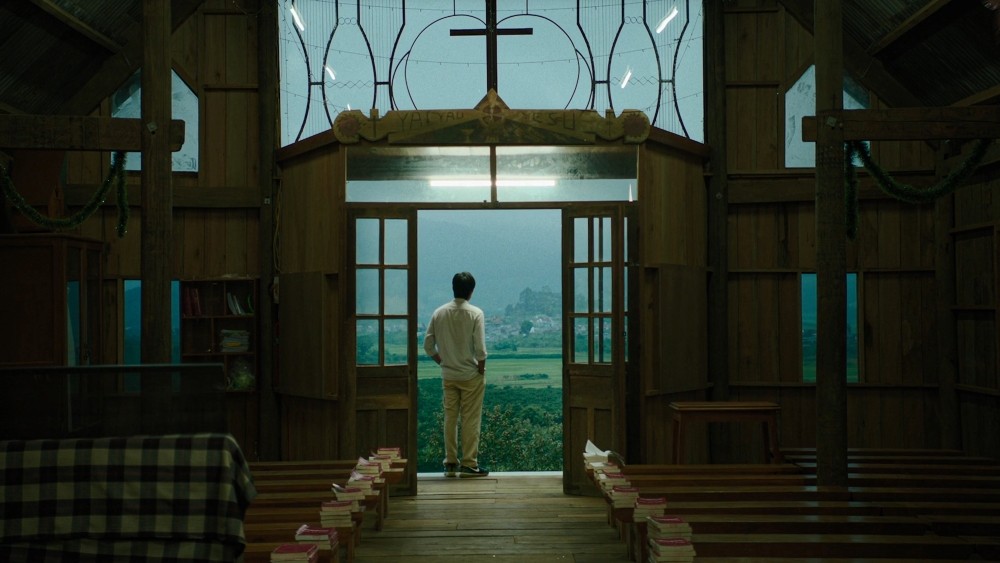
All of life, including death, is in the lengthy, unbroken shot that opens Thien An Pham’s bewitching debut feature “Inside the Yellow Cocoon Shell.” We begin on the sidelines of a local soccer match in Saigon’s city center, observing the play from a cool distance before following a shuffling mascot, dressed in a wolf suit, to the adjoining bar. There, crowds watch a 2018 World Cup fixture while a group of young men, turned from the TV, drink and discuss matters of faith, existence and ennui. Thien (Le Phong Vu) is quiet and morose, only half-invested in a conversation already beset with distractions: the sales pitch of a bubbly beer rep, the burst of a sudden summer thunderstorm, a metallic screech and grim thump as the camera again drifts serenely over to reveal the aftermath of a fatal motorcycle crash. In the ensuing rhubarb of bystander concern, Thien stays put.
The absence of cuts in this immaculated choreographed long take feels not merely like technical show-offery, but a reflection of Thien’s own detached presence in a world passing him by. It’s only later, in the middle of an erotic massage at a gentlemen’s spa, that he learns the casualty of the crash was his sister-in-law Hanh; its survivor, his five-year-old nephew Dao (Nguyen Thinh). It’s an acidly comic way into tragedy, cuing a wandering spiritual inquiry that will take in many such dazzling shifts in tone and perspective along the way, all wrangled with preternatural confidence and formal invention by its young director.
Fully delivering on the promise of Pham’s well-traveled shorts — one of which, 2019 Cannes Directors’ Fortnight winner “Stay Awake, Be Ready,” was the root for this feature — this is challenging but seductive art cinema that invites comparisons to such titans as Apichatpong Weerasethakul, Tsai Ming-liang and even Theo Angelopoulos, without feeling derivative of any. A standout in this year’s Fortnight program and among the most auspicious debuts to pop at Cannes of late, “Cocoon Shell” should attract attention from specialist distributors undaunted by the film’s esoteric edges and languorous but rewarding three-hour runtime.
At the film’s heart is a warmly affecting story of loss and grief — for the dead, but also for alternate lives and opportunities missed — albeit one that reaches its emotional epiphanies in subtle, circuitous ways. In the absence of Hanh, the ill-equipped Thien becomes Dao’s temporary guardian; Tam, Dao’s dad and Thien’s brother, has been AWOL for years. Together, man and boy leave the city, accompanying Hanh’s corpse to their remote home village, where the rituals of burial and mourning in the local Christian community are observed in rapt, reverent detail.
Thien, not a believer himself, has few words of assurance or consolation for his confused young nephew, though he’s not unreceptive to the comfort others find in faith, or the marvels of the living world. He adopts and nurtures an abandoned baby bird, before it, too, perishes and must be buried; he reunites with an old flame, now a nun at the convent school he wants Dao to attend, but they’re separated by differing ideas of the divine. Pham repeatedly thwarts convenient metaphors for redemption and renewal, as Thien must instead embark on a more complicated, irregular search through the wilderness — ostensibly for Tam, but essentially for his own soul, for an elusive sense of place and purpose.
There is much obvious beauty in this lush, rural Vietnamese hinterland, as DP Dinh Duy Hung’s meticulous, intricately staggered compositions paint in the rich, wet greens of the surrounding forest, the mineral blues of weather-heavy skies and the interrupting gauze of mist over everything. But “Inside the Yellow Cocoon Shell” (the title of which, too, hints at ideas of natural and spiritual transition that the film resists making literal) is never dully picturesque: No landscape is shown here without a precise sense of how characters view and respond to it.
Extraordinarily layered, fevered sound design, meanwhile, ensures that even the film’s most notionally quiet, pensive scenes feel bustlingly inhabited across the ecosystem. Much of the dialogue is woven through competing input from livestock, birdsong, wind, dripping water and radio chatter. These tangible sources ground us even as the film’s sense of time lapses and collapses, as past and present, waking and dreaming, earthly and ethereal states begin to slip casually into one another, and Thien’s quest circles futilely before arriving at a kind of grace anyway. “I cannot exist simultaneously in the light and in the dark,” Thien says at one point; in offering a splintered, elastic conception of spiritual identity, outside the rules of religious doctrine, Pham’s exquisite film suggests otherwise.













